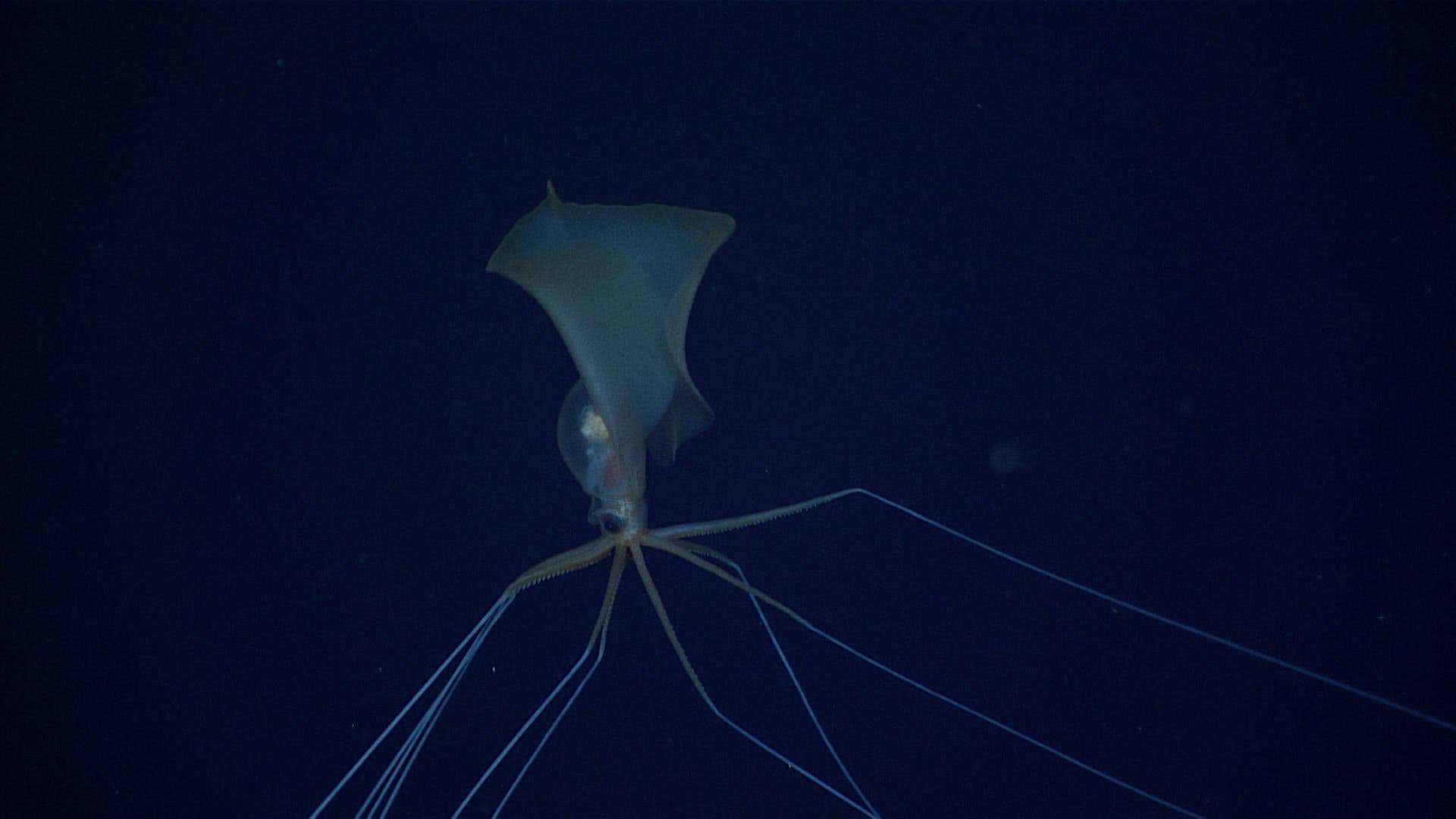
The magnapinna squid is proof that life on Earth can be very diverse, and sometimes, outright weird.
In the vast depths of the ocean, that’s doubly true. To adapt to the frigid, high-pressure, and dark environment of the deep sea, many creatures have undergone special adaptations that allow them to survive. The magnapinna squid (or bigfin squid) is one of these creatures. With its alien-like physical appearance and ghostly long, thin tentacles, it’s quite a sight to behold.
The bigfin squid: a deep-sea squid
The magnapinna squid or the bigfin squid is an ethereal creature and poorly understood creature. It lives in the deep parts of the oceans and is one of the most mysterious creatures in the sea. The first visual record of an adult bigfin squid was at a depth of 4,735 metres (15,535 ft). Most sightings are at depths of over 2,000 meters (6,500 feet).
Remarkably, a submersible sent to investigate the wreck of the USS Johnston (the deepest shipwreck) also found a juvenile bigfin squid. Just off the Philippine Trench, at a depth of 6,212 meters (20,381 ft), the juvenile magnapinna was just chilling. This is the deepest observation of any squid ever. In fact, it’s only rivaled by by some unidentified cirrate octopods as the deepest observation of any cephalopod. This makes Magnapinna the first squid known to inhabit the hadal zone — the deep parts of the oceans.
“This observation is the first record of squid at hadal depths and extends the known bathymetric range for any squid by 1477 m; an increase of ca. 30%,” the researchers wrote in the study.
Large body, large tentacles
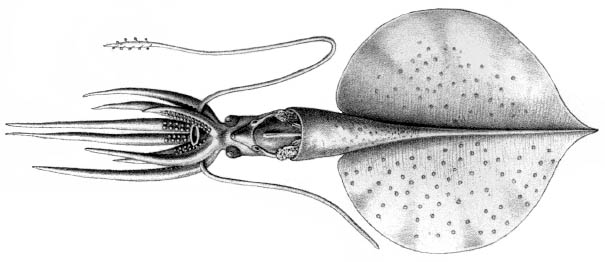
These squids are true to their name (‘magna’ means ‘great’ and ‘pinna’ is the external part of the ear). They have heart-shaped fins that are much larger than their body. The magnapinna squid also has extremely long arms and tentacle filaments measuring 11 times longer than their body length.
The squid can measure 26 feet (8 meters) in length from the top of its head to the end of its tentacles. Remarkably, its arms and its tentacles are the same length and look identical. In squids, as well as in other cephalopods like octopuses and cuttlefish, there’s a distinct difference between arms and tentacles, both in terms of structure and function. All squids have eight arms, which are typically shorter and thicker. In addition to their eight arms, squids also have two tentacles, which are usually longer and thinner.
In the magnapinna squid, the arms and tentacles are very similar — this is unlike any squid or octopus that lives today and has only been observed in extinct creatures called belemnites.
Another difference between arms and tentacles is that arms have a line of suckers going down the entire length, whereas tentacles don’t have suckers until you get to the tentacular clubs. With a few exceptions, octopuses have eight arms and no tentacles, while squid and cuttlefish have eight arms (or two “legs” and six “arms”) and two tentacles.
Arms and tentacles and tangling
Dr. Mike Vecchione, the curator of the Smithsonian National Museum of Natural History and leading expert on squids, explained that in most cases squids use their arms and tentacles for different purposes but this does not apply to bigfin squids.
Researchers assume that they use their tentacles and arms for the same goal — feeding. The squid uses its sticky spaghetti-like appendages like a net. It lays down a curtain of appendages and then waits for its unfortuate prey. But this strategy can also backfire, especially when the squid interacts with humans.
The arms and tentacles have many microscopic suckers. This is useful in catching prey, but it can also get them in trouble. For instance, they can sometimes get tangled and get stuck to unwanted objects (like submersibles).
But these magnificent creatures also have an adaptation that prevents unwanted tangling.
The appendages were oddly bent, almost as if they were dangling puppet strings. The elbow-like kinks in its arms and tentacles generally prevent it from getting the tentacles twisted with one another. This allows the creature to just drape gracefully as it wanders the waters. It also creates a very bizarre perspective, as you can see.

Many unknowns about the magnapinna squid
But these unusual creatures inhabit the ocean’s dark zone as deep as 16,000 feet (4.8 km), which makes them very elusive and extremely hard to study. In fact, there are only a few recordings of them, and most are very recent. In fact, most of what we know about them comes from videos captured by remotely operated vehicles (ROVs).
It’s not entirely clear how the magnapinna squids feed. However, researchers have several theories: one of them is that they drag their arms and tentacles on the floor grabbing edible organisms. Another theory is that they simply use a trapping technique, waiting passively for prey like zooplankton to get trapped in their sticky tentacles.
Ultimately, we don’t know exactly how they use their appendages. We also don’t know exactly what they eat. Cephalopods usually feed on crustaceans, jellyfish, and even other cephalopods, so we can probably assume the magnapinna squid does the same. But there are few certainties.
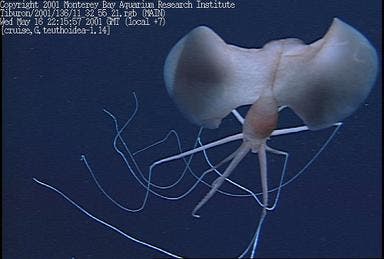
The phantom of the deep sea
The magnapinna squid is a relatively newly discovered creatures. Researchers only properly described it 20 years ago. Scientists found the first specimen in the Azores islands in Portugal in 1907. However, that specimen was very damaged and incomplete. In 1956, scientists found another specimen. This one was illustrated in Alister Hardy‘s The Open Sea (1956) — but it was wrongly classified. The magnapinna was then again spotted once in 1988, twice in 1992, once in 1998, three times in 2000, once in 2001 and 2007.
But because it lives so deep under the surface and it rarely strays to the surface, it remained very elusive. That’s why it took so long for researchers to describe it as an individual species. In fact, scientists only started understanding the species somewhat when remotely operated vehicles became popular.
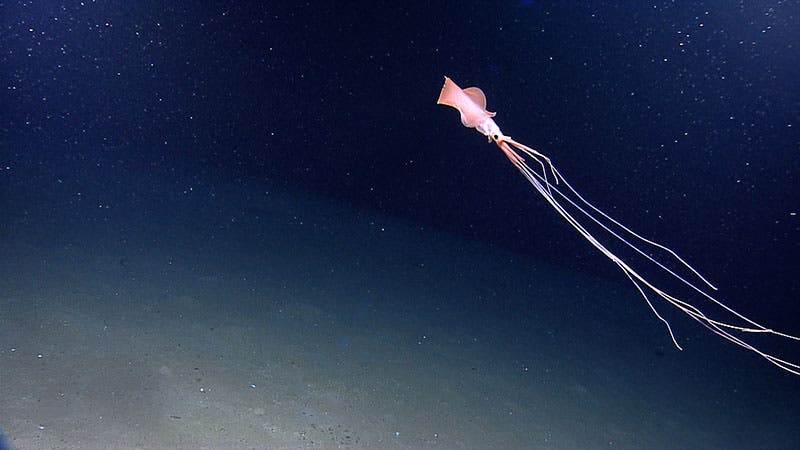
Despite the few sightings, researchers suspect that the magnapinna squid is spread in many areas around the world.
New bigfin sightings
Just recently, in 2020, there was a sighting in southern Australia. This suggests that the distribution of these creatures may be more cosmopolitan than previously thought. It was the first ever sighting in Australia. Suprisingly, researchers identified not only one but five individuals that were in close proximity to each other — something never seen before.
These Australian squids also had some surprising behavior. There was one squid who did a “raised arm” posture. This was never reported in previous sightings. Researchers also found a juvenile bigfin squid that provided an unprecedented opportunity to study the life cycle of this mysterious group of squids.
“Squid of a juvenile size were also recorded and are confirmed to possess the long distal filaments which have thus far been mostly missing from specimens due to damage,” wrote the researchers from Australia’s CSIRO Oceans and Atmosphere.
However, scientists have never found a single live specimen yet. This makes describing the species still very challenging. The closest scientists can get to these creatures, for now, is through video captures from ROVs.
Ultimately, we barely know anything about the bigfin squid, and the same goes for plenty of creatures in the deep ocean — including many we haven’t even encountered yet.
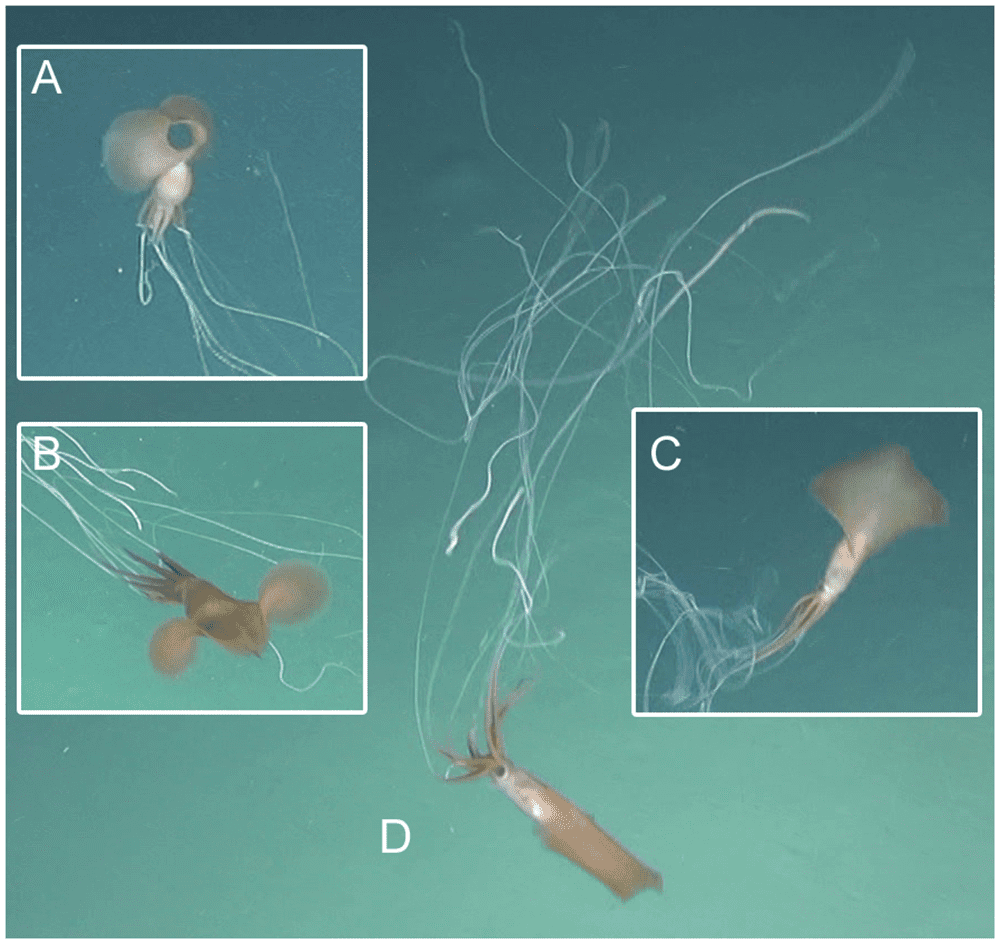
Plenty of mysteries left
It’s hard to know just how many of these creatures are. The ocean is so vast that every time an ROV goes in, it’s a bit like a needle in the haystack — it’s a challenge to know if what you’re seeing is representative of the greater picture. We don’t know how many species there are, how many individuals there are, and how these individuals behave.
However, while they’re very inaccessible to humans, bigfin squids are also vulnerable to anthropogenic activities, especially with climate change altering water temperatures and food availability. Furthermore, deep-sea mining poses a threat to the known habitats of these species, especially as mineral exploration in the depths of the sea is becoming a more attractive proposition for many companies (despite the opposition of scientists and environmentalists).
Though bigfin squid lives thousands of meters deep into the ocean, we should not be complacent as in one way or the other, our irresponsible decisions can impact them negatively. Otherwise, we may risk destroying them before we even get a chance to know them.


